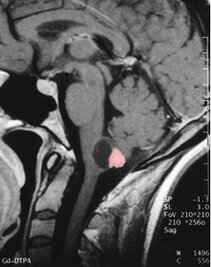Hemangioblastomas and von Hippel-Lindau (VHL) disease
NeurosurgeryHemangioblastomas
What is a hemangioblastoma?
Hemangioblastomas of the central nervous system are benign tumors. They mostly occur in the posterior fossa or spinal cord. These tumors can develop sporadically or hereditarily as a manifestation of von Hippel-Lindau disease. Typically, the tumors develop an adjacent tumor-associated cyst as a small, solid formation along the wall of a large cyst. These cysts contain an amber-colored liquid and in some cases form a so-called syrinx in the spinal cord. The tumors abundantly produce erythropoietin, commonly known as the doping agent Epo. This can lead to an increase in the production of red blood cells in affected patients.

Figure 1: Hemangioblastoma in the cerebellum (highlighted in pink).
What are the symptoms of these benign tumors?
Symptoms of hemangioblastomas in the cerebellum mainly include headaches, nausea, incoordination, unsteady gait and dizziness. In progressive tumors it can also lead to disorders of consciousness. Patients affected by tumors of the spinal cord may develop numbness or paralysis. In addition, an unsteady gait may occur. Difficulties with defecation and urination are some of the other possible symptoms. The tumors rarely cause pain.

Figure 2: Hemangioblastoma of the spinal cord (highlighted in pink).
What is the medical treatment?
In general, the tumors grow slowly so that an annual check-up is sufficient. For the primary diagnosis and follow-up examination, an MRI with contrast is the method of choice. If treatment is necessary, the tumor is removed microsurgically. Since hemangioblastomas are benign tumors, the tumors can usually be completely removed and generally do not recur. Radiation therapy has so far provided no convincing evidence of success. Drug therapy methods are currently the subject of scientific investigation. There is currently no drug that has been shown to be effective against hemangioblastomas.
von Hippel-Lindau (VHL) disease
What is von Hippel-Lindau disease?
VHL is a hereditary tumor syndrome named after doctors Eugen von Hippel and Arvid Lindau who discovered the disease in the early 20th century. Besides hemangioblastomas, the VHL disease can cause tumors of the retina (retinal angiomas), renal tumors and tumors of the adrenal gland (pheochromocytoma). In addition, tumors in the inner ear, the epididymis and the pancreas can occur.
What is the treatment for von Hippel-Lindau disease?
Patients affected by VHL disease usually develop multiple hemangioblastomas. This circumstance must be taken into consideration in the surgical treatment. Because the appearance of new tumors has always to be expected, a definitive cure is not possible surgically. Although the removal of hemangioblastomas of the CNS is usually carried out without long-term damage, the removal of all tumors in patients with VHL disease is not considered the most reasonable option. For these reasons, the following procedure is considered most reasonable: patients with VHL disease are monitored by annual MRI of the brain and spinal cord. It is then discussed individually which tumors should be removed. Generally, it is advisable to remove those hemangioblastomas which cause discomfort. In asymptomatic tumors that grow in size and develop a tumor-associated cyst over the course, we mostly recommend removal. This is based on comparisons we made in the state of a large number of patients before and after surgery. This comparison demonstrated that there is generally no change in complaints of functionality. Although this means that no permanent damage is normally caused by an operation, it was found that any issues that did occur before surgery could no longer be corrected by surgery. We therefore consider it most ideal to remove the tumors at a time when they cause no discomfort. Therefore, we do still operate on tumors that are (still) asymptotic but show growth.